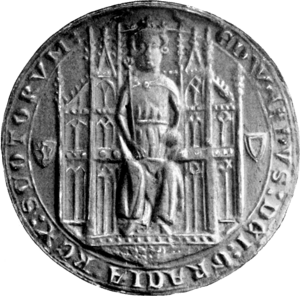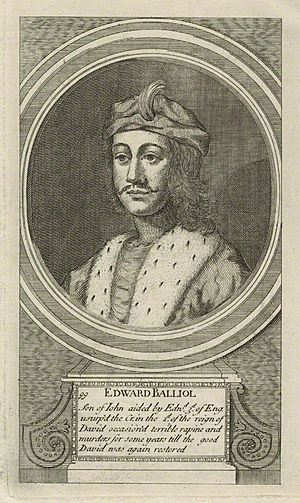Edward Balliol facts for kids
Quick facts for kids Edward Balliol |
|
|---|---|

Edward's seal
|
|
| Claimant to the throne of the Kingdom of Scotland | |
| Tenure | 24 September 1332 – 20 January 1356 |
| Born | c. 1283 Cavers, Roxburghshire, Kingdom of Scotland |
| Died | January 1364 (aged around 81) Wheatley, Doncaster, Kingdom of England |
| House | Balliol |
| Father | John Balliol |
| Mother | Isabella de Warenne |
| Religion | Roman Catholicism |
Edward Balliol (Scottish Gaelic: Èideard Balliol; c. 1283 – January 1364) was a claimant to the Scottish throne during the Second War of Scottish Independence. With English help, he ruled parts of the kingdom from 1332 to 1356.
Early life
Edward was the eldest son of John Balliol and Isabella de Warenne. As a child, Edward was betrothed to Isabelle of Valois, the eldest daughter of Charles, Count of Valois (1271–1325) and his first wife Marguerite of Anjou (1273–1299). His father John resigned his title as King of Scotland in 1296, and it was likely this that caused the King of France to break the marriage contract and betroth Isabelle instead to John son of Arthur II, Duke of Brittany.
Following his father's abdication, Balliol resided in the Tower of London until 1299, when he was released into the custody of his grandfather John de Warenne, 6th Earl of Surrey. Balliol was likely involved in the "Soules Conspiracy", a plot to depose king Robert I and install Balliol on the throne led by William II de Soules. Balliol possibly married Margaret of Taranto, daughter of Philip I, Prince of Taranto around 1331. If this marriage did take place, it was childless and had been annulled by the time Balliol made his bid for the Scottish crown in 1332.
Claimant to the Scottish throne
The death of King Robert I in June 1329 left his six-year-old son David II as King and one of King Robert's ablest lieutenants, Thomas Randolph, the Earl of Moray, as regent. Around this time, Balliol was recruited by "the disinherited", men whose Scottish lands and titles had been confiscated by Robert I following the Battle of Bannockburn. These men included Henry de Beaumont, David III Strathbogie, and Gilbert de Umfraville, son of Robert de Umfraville, Earl of Angus. In 1332 the disinherited and Balliol made plans for an invasion of Scotland, covertly supported by Edward III of England. Following the death of Randolph on 20 July 1332, the disinherited along with several English adventurers such as Walter Manny and Thomas Ughtred invaded. Balliol's forces defeated the new regent, the Earl of Mar, at the Battle of Dupplin Moor in Perthshire on 11 August 1332.
Edward Balliol was crowned at Scone on 24 September 1332, but three months later he was forced to flee back to England, following a surprise attack by nobles loyal to David II at the Battle of Annan. On his retreat from Scotland, Balliol sought refuge with the Clifford family, land owners in Westmorland, and stayed in their castles at Appleby, Brougham, Brough, and Pendragon.
In early 1333, Edward III openly declared his support for Balliol as king. Balliol returned to Scotland with Edward and an English army in the summer, Capturing Berwick and defeating the Scottish forces at the Battle of Halidon Hill. Balliol, under the Treaty of Newcastle (1334), then ceded the whole of the district formerly known as Lothian to Edward and paid homage to him as liege lord while staying in Blackfriars friary in Newcastle upon Tyne. He was also betrothed to Edward III's sister Joan of the Tower, who was already married to David II. Despite David II fleeing Scotland for France, Balliol's position was still not secure, and infighting between his supporters along with frequent fighting from pro-Bruce forces caused Balliol to flee Scotland once again. In November 1334, Edward III and Balliol invaded again, but unable to bring the Scots to battle, they retreated in February 1335. On 30 November 1335, a pro-Balliol army under the command of Strathbogie was defeated at the Battle of Culblean, which was the effective end of Balliol's attempt to overthrow the King of Scots.
In early 1336 a truce was proposed with intervention from Philip VI of France. The truce would have recognized Balliol as king and allowed him to marry princess Joan, and David II would become his heir. David however, rejected the treaty. Edward III and Balliol returned again in July 1336 with a large English army and advanced through Scotland, first to Glasgow and then to Perth, destroying the surrounding countryside as they went but by late 1336, the Scots had regained control over virtually all of Scotland, and by 1338 the tide had turned against the usurper.
Edward Balliol returned to Scotland after the defeat of King David II at the Battle of Neville's Cross in 1346 and with a small force raised an insurrection in Galloway in a final attempt to gain the crown of Scotland. He only succeeded in gaining control of some of Galloway, with his power diminishing there until 1355.
Final years
On 20 January 1356, Balliol surrendered his claim to the Scottish throne to Edward III in exchange for an English pension. He spent the rest of his life living near Yorkshire and died childless in January 1364, at Wheatley, Doncaster. The location of his grave has been speculated to be under a Doncaster Post Office.
See also
 In Spanish: Eduardo de Balliol para niños
In Spanish: Eduardo de Balliol para niños


